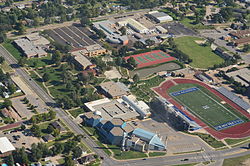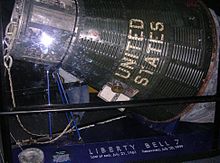Cosmosphere
 Main entrance (2003) | |
Location within Kansas | |
| Established | 1962 |
|---|---|
| Location | 1100 North Plum Street Hutchinson, KS 67501 USA |
| Coordinates | 38°03′55″N 97°55′17″W / 38.065304°N 97.921344°W |
| Type | Space Museum |
| Collection size | 15,000 |
| Visitors | 150,000 / year |
| CEO | Jim Remar |
| Website | cosmo.org |

Cosmosphere is a space museum and STEM education center in Hutchinson, Kansas, United States. It was previously known as the Kansas Cosmosphere. The museum houses over 13,000 spaceflight artifacts - the largest combined collection of US and Russian spaceflight artifacts in the world, and is home to internationally acclaimed educational programs.
Facilities
The Cosmosphere grew from a planetarium established on the Kansas State Fairgrounds in 1962. The 105,000-square-foot (9,800 m2) facility houses the largest collection of Russian space artifacts outside of Moscow, and a collection of US space artifacts second only to the National Air and Space Museum in Washington, D.C..[1][2]
The Cosmosphere has four venues: The Hall of Space Museum, The Justice Planetarium, The Carey Digital Dome Theater, and Dr. Goddard's Lab (an explosive live science presentation on the history of rocketry). The Cosmosphere also hosts summer camps for all ages, and co-curricular applied STEM education programs for field trips, groups, and scouts that meet Next Generation Science Standards and common core, focused on college and career readiness.
The Cosmosphere is the only Smithsonian affiliate museum in Kansas.[3]
In 2012, the Carey Digital Dome Theater upgraded from IMAX to 4K digital projection.[4]
In 2015, the Justice Planetarium underwent a complete renovation, transitioning from an optical starball projection system to the Spitz Sci-Dome XD digital projection system.[5]
Restoration and replication
The Cosmosphere's SpaceWorks division has restored flown U.S. spacecraft for museums and exhibits across the globe, including artifacts that are part of the collection of the Smithsonian Institution National Air and Space Museum.[6] Two examples of this work are the Apollo 13 Command Module Odyssey, and the Liberty Bell 7 - both on display at the Cosmosphere. The Cosmosphere built roughly 80% of the artifacts and props for the movie Apollo 13 and of the replicated spacecraft hardware seen in Magnificent Desolation: Walking on the Moon 3D; and the TV mini-series From the Earth to the Moon.[7]
Collection







Flown items included in the Cosmosphere's collection are a Lockheed SR-71 Blackbird, the Liberty Bell 7 Mercury spacecraft, the Gemini 10 space capsule, and the Command Module Odyssey from Apollo 13. Additionally, authentic Redstone and Titan II launch vehicles used in the Mercury and Gemini programs flank the building's exterior.[8] A prized item on display is a Moon rock from Apollo 11, the first manned mission to land on the Moon.
Every artifact on display at the Cosmosphere is either an actual flown artifact, a "flight-ready backup" (identical to the item actually flown), an engineering model, or an historically accurate replica.
The Cosmosphere museum begins with the earliest experiments in rocketry during the World War II era, explores through the Space Race and Cold War, and continues through modern times with the Space Shuttle and International Space Station, as well as SpaceShipOne and commercial spaceflight.
Notable Items on display:
- Germany
- Restored World War II German V-1 flying bomb missile (authentic)
- Restored World War II German V-2 rocket (authentic)
- Section of the Berlin Wall - last section removed (authentic)
- Russia / Soviet Union / USSR
- Sputnik 1 (flight-ready backup) [9]
- Apollo-Soyuz Test Project Craft (joint venture with USA)
- Vostok space capsule (competitor against Mercury program)
- Voskhod 2 space capsule (competitor against Gemini program)
- Prototype and flown Russian space suits
- United States
- Winged aircraft
- Lockheed SR-71 Blackbird reconnaissance plane (flown)
- North American X-15 rocket engine (flown)
- Replica of the Bell X-1 Glamorous Glennis, used in the filming of The Right Stuff movie
- Engine from Bell X-1 Glamorous Glennis, pilot Chuck Yeager (flown)
- Mercury space program
- Liberty Bell 7 Mercury spacecraft, recovered from the bottom of the Atlantic Ocean. It is the only spacecraft flown by NASA but owned by an entity other than NASA or the Smithsonian (owned by Cosmosphere).
- Mercury-Redstone Launch Vehicle rocket (authentic) (standing vertical outdoors)
- Gemini space program
- Apollo space program
- Apollo 13 command module Odyssey (flown)
- Lunar Roving Vehicle (full-scale replica)
- Lunar Module (full-scale replica)
- Apollo White Room (authentic)
- Moon rock collected during Apollo 11
- Space Shuttle space program
- Full-scale replica of Space Shuttle Endeavour (left side only)
- Piece of tile from the Space Shuttle Columbia disaster (flown)
- Various space programs
- Vanguard 1 satellite (flight-ready backup)
- Prototype and flown American space suits
Education
The Cosmosphere hosts summer camps for all ages, and co-curricular applied STEM education programs for field trips, groups, and scouts that meet Next Generation Science Standards and common core, focused on college and career readiness.
Scouting
The Cosmosphere is a site for many programs for various scouting groups. There are programs available for Boy Scouts, Girl Scouts, and American Heritage Girls that meet program requirements and help scouts earn merit badges.
Controversy
In November 2003, the Cosmosphere released a statement indicating that a routine audit had revealed many missing items from the museum. Over a year later, in April 2005, former Cosmosphere director Max Ary was charged with stealing artifacts from the museum's collection and selling the pieces for personal profit.[10] Some of the missing items included a nose cone, silk screens, boot covers, nuts and bolts, an Air Force One control panel, and a tape of the Apollo 15 landing which Ary sold for $2,200.
Additional charges involved the theft of dozens more artifacts from the Cosmosphere when he left in 2002, and false insurance claims made on the loss of an astronaut's Omega watch replica. Ary had also failed to notify NASA of the loss of the watch.
Ary went on trial in 2005. He testified that the artifacts he sold were from his private collection which he had accumulated through undocumented trades and salvage of unwanted items. He also stated he had received numerous personal gifts from astronauts. Some of the items in question were supposedly brought with him from the Noble Planetarium in 1976 and incorporated into the Cosmosphere's permanent collection, and in many cases, ownership of artifacts could not be proved on Ary's behalf or the Cosmosphere's.
Ary was found guilty on 12 counts. On May 15, 2006, he was sentenced to three years in prison and ordered to pay restitution of $132,000. In 2008 he lost his appeal, and began to serve his sentence in a federal prison in El Reno, Oklahoma on April 24, 2008.[11][12] Ary has repeatedly proclaimed his innocence. He was released on good behavior in June 2010.
See also
- Strataca, salt mine museum, in Hutchinson
- Combat Air Museum in Topeka
- Kansas Aviation Museum in Wichita
- Mid-America Air Museum in Liberal
- List of aerospace museums
- List of museums in Kansas
References
- ^ cosmo.org
- ^ "Louisburg Herald". Herald-online.com. 2012-02-15. Retrieved 2012-02-21.
- ^ Rothschild, Scott (2008-01-30). "8 Wonders of Kansas revealed / LJWorld.com". .ljworld.com. Retrieved 2012-02-21.
- ^ Cosmosphere changes from IMAX to digital theater; KSN; October 6, 2012.[permanent dead link]
- ^ Cosmosphere's planetarium to undergo complete renovation; KAKE tv; January 30, 2015. Archived October 19, 2015, at the Wayback Machine
- ^ Cosmosphere Restoration Archived 2015-12-18 at the Wayback Machine
- ^ [1][dead link]
- ^ Kansas Cosmosphere gets ICBM built in 1960s; Lawrence Journal World; April 26, 1989.
- ^ "Hutchinson, KS - Kansas Cosmosphere and Space Center". Roadsideamerica.com. Retrieved 2012-02-21.
- ^ "United States v. Ary". FindLaw. Retrieved 23 February 2019.
- ^ Vandruff, Ken (May 16, 2006) "Ary given three-year prison term" Wichita Business Journal
- ^ Green, John (May 5, 2008) "Ruling on Ary stands" hutchnews.com
External links
- Official website
- Cosmosphere info and photos, kansastravel.org
- We Are The Explorers, NASA Promotional Video (Press Release)
- Hutchinson City Map, KDOT

